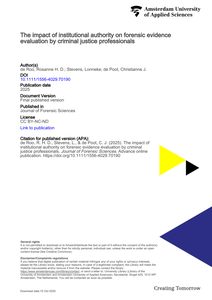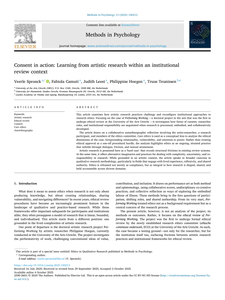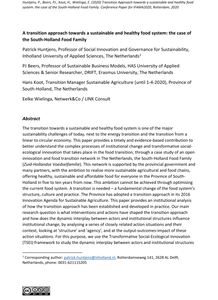Accurate and reliable decision-making in the criminal justice system depends on accurate expert reporting and on the correct interpretation of evidence by the judges, prosecutors, and defense lawyers. The present study aims to gain insight into the judiciary's capability to assess the accuracy and reliability of forensic expert reports by first examining the extent to which criminal justice professionals are able to differentiate between an accurate (or sound) expert report and an inaccurate (or unsound) expert report. In an online questionnaire, 133 participants assessed both a sound and an unsound expert report. The findings show that, on average, participants were unable to significantly distinguish between sound and unsound forensic expert reports. Second, the study explored the influence of institutional authority on the evaluation of forensic expert reports. Reports that were not recognized as flawed—particularly those originating from well-known and reputable institutions—were subjected to less critical examination, increasing the risk of evaluation errors. These results suggest that the perceived institutional authority influences the assessment of forensic evidence. The study highlights the need for tools to support criminal justice professionals in evaluating forensic evidence, particularly when experts are unregistered. Recommendations include adhering to established quality standards, consulting counter-expert evaluations, improving courtroom communication, and enhancing forensic knowledge through training. Overall, the findings underscore the importance of critical evidence evaluation to reduce the risk of misinterpretation and wrongful convictions in the judicial process.
DOCUMENT

This study theorizes on the sociomateriality of food in authority-building processes of partial organizations by exploring alternative food networks (AFNs). Through the construction of arenas for food provisioning, AFNs represent grassroots collectives that deliberately differentiate their practices from mainstream forms of food provisioning. Based on a sequential mixed-methods analysis of 24 AFNs, where an inductive chronological analysis is followed by a qualitative comparative analysis (QCA), we found that the entanglements between participants’ food provisioning practices and food itself shape how authority emerges in AFNs. Food generates biological, physiological and social struggles for AFN participants who, in turn, respond by embracing or avoiding them. As an outcome, most AFNs tend to bureaucratize over time according to four identified patterns while a few idiosyncratically build a more shared basis of authority. We conclude that the sociomateriality of food plays an important yet indirect role in understanding why and how food provisioning arenas re-organize and forge their forms of authority over time. Pascucci, S., Dentoni, D., Clements, J., Poldner, K., & Gartner, W. B. (2021). Forging Forms of Authority through the Sociomateriality of Food in Partial Organizations. Organization Studies, 42(2), 301-326. https://doi.org/10.1177/0170840620980232
DOCUMENT

In 2005 and 2006, almost sixty Dutch National Sport Federations (NSFs) participated in a special program for creating a marketing strategy for the next four years. This program was initiated and organized by NOC*NSF (the Dutch Olympic Umbrella Sports Organization). The NSFs had to joint the project to receive funds. For most of them it was the first time they seriously analyzed the market with the aim of developing new programs. The purpose of this paper is to explore to what extent Dutch NSFs are capable to change their structures to become more market oriented and more market responsive in order to write strategic plans. The changed structures are investigated using the "institutional theory" (Tolbert & Zucker, 1996) and are explained by exogenous (market context and institutional context) and endogenous (interests, values, power dependencies, and capacity for action) dynamics from the neo-institutionalist framework (Greenwood & Hinings, 1996). In 2005 NSFs were expected to be in a pre-institutionalized stage, i.e. they were supposed to develop new organizational structures in response to specific problems (Kikulis, 2000). Now, approximately 1½ years after finishing their strategies, the question arises whether they have reached the semi-institutional stage, i.e. whether the new structures or actions are diffused across organizations, yet still subject to change and whether old structures are yet eroding (Kikulis, 2000). Methods Studying the intended structural change of NSFs requires an in-depth study of their social reality and the reactions and interpretations of involved actors, including their applied meanings to certain situations. Greenwood & Hinings (1996) plead for detailed comparative case-studies when studying institutional changes. Therefore three NSFs has been selected: The Royal Dutch Korfball Federation (KorfFed); The Royal Dutch Billiards Federation (BillFed); and the Dutch Jeu de Boules Federation (JeuFed). These three federations differ on size, amount of housed sports, number of associated clubs, sorts of intermediary decision making bodies, employed FTE's, and more. Therefore it is expected that the tempo of institutionalization of the new, market oriented, structures, will differ among them. Sugden & Tomlinson (2002) developed a multi-method style of qualitative research for making sense of the deep, inside information below the surface of everyday life. They call it the "Brighton method. Applying the Brighton method for this research implies that the three cases will be studied with respect to their history, their present marketing actions, their results and the changes in their organization. In-depth interviews, document analysis (policy plans, marketing plans and more), and where possible observations and participations are used to create a critical and investigative view of the organizations in change. Results The KorfFed used the marketing program to further develop existing programs. Although the outcomes of these programs were not new, the program has opened the eyes of the president, director and staff members. They are now conscious of the urgency of a market orientation, and a marketing orientation (a marketing position has already been introduced), and they see opportunities in attracting non-competition playing korfball players. They have, however, not yet reached the phase of semi-institutionalization of the market oriented structures. This can be concluded from the following: - The organization still has an ad-hoc character; - Some board members still make decisions based on their own insights rather than on information from the professional part of the organization; - Decisions to start programs are still grounded on subsidy possibilities rather than on market possibilities. Interest dissatisfaction and power dependencies are the main dynamics that form barriers in the planned organizational change. The BillFed is a federation that covers four disciplines, i.e. pool, snooker, carom, and billiard 3 cushions. The federation used to act upon these four disciplines. The marketing program has made clear that the BillFed should act upon target groups instead of on these disciplines. Therefore, the federation created a vision to reach youth, young adults, as also elderly people. Carrying out this new vision requires a market orientated structure (focus on target groups) instead of an internal orientated structure (focus on discipline groups). This new vision is created on an upper level (general board together with professional staff) in the organization. This federation also introduced a professional marketing position. Unfortunately, the underlying layers remain slightly passive and are not willing to work along the new structures, which mean that the new structures have not been diffused across the whole organization. Interest dissatisfaction, value commitments and power dependencies are the problematic dynamics. The JeuFed used to have a strong competition and tournament (internal) orientation, while many jeu-de-boules players play the game just for fun. The marketing program has created the insight that the just-for-fun players are also an important target group. Hence, 3 projects are developed to make club membership more attractive for all jeu-de-boules players. Since the federation never worked with projects before, they just found out that implementing projects such as these requires new structures. The JeuFed has just arrived in the pre-institutionalized phase, still far away from the semi-institutionalized chapter. Power dependencies and a lack of capacity for change are influencing dynamics in this case. Discussion Although it is already 1½ years ago that Dutch NSFs finished their marketing program, in none of the described cases the new structures have reached the semi-institutional stage. These new structures or actions are not yet diffused across the organizations, and the old structures are not eroding. In all three cases another combination of endogenous dynamics are influencing the process of organizational change. Continuing research is needed to find out whether these federations will ever reach the next stage of institutionalization and which dynamics will play an important role.
DOCUMENT
The literature on how organizations respond to institutional pressure has shown that the individual decision-makers’ interpretation of institutional pressure played an important role in developing organizational responses. However, it has paid less attention to how this interpretation ultimately contributes to their range of organizational decisions when responding to the same institutional pressure. We address this gap by interviewing board members of U.S. and Dutch hospitals involved in adopting best practices regarding board evaluation. We found four qualitatively different cognitive frames that board members relied on to interpret institutional pressure, and which shaped their organizational response. We contribute to the literature on organizational response to institutional pressure by empirically investigating how decision-makers interpret institutional pressure, by suggesting prior experience and role definition as moderating factors of multidimensional cognitive frames, and by showing how these cognitive frames influence board members’ response to the same institutional pressure.
DOCUMENT

Inclusief onderwijs staat hoog op de agenda van De Haagse Hogeschool. Sinds januari 2021 is Naomi van Stapele lector Inclusive Education bij het kenniscentrum Global & Inclusive Learning. In deze intreerede van september 2022 wordt o.a. ingegaan op onzekerheid, de drie leidende beginselen van inclusief onderwijs, de ethische politiek van inclusiviteit, etc.
DOCUMENT

This paper analyses the ways in which informal mediation channels facilitate service delivery in the Citizen Service Bureaus at the Municipal Corporation of Delhi and give rise to an interplay between formal and informal institutions. In particular, the personal backgrounds of brokers as informal mediators and how they ensure their acceptance amongst service seekers are explored. Further, the motivations of the service seekers to solicit help from these mediators as well as institutional responses from the municipal administration along with other relevant actors like the Government of National Capital Territory of Delhi are examined.
MULTIFILE

This article examines how artistic research practices challenge and reconfigure institutional approaches toresearch ethics. Focusing on the case of Performing Working —a doctoral project in the arts that was the first toundergo ethical review at the University of the Arts Utrecht —it investigates how forms of consent, researcherroles, and institutional responsibility are negotiated when research is processual, embodied, and collaborativelydeveloped.The article draws on a collaborative autoethnographic reflection involving the artist-researcher, a researchparticipant, and members of the ethics committee. Care ethics is used as a conceptual lens to analyse the ethicaldimensions of the case, foregrounding relationality, vulnerability, and attention to power. Rather than treatingethical approval as a one-off procedural hurdle, the analysis highlights ethics as an ongoing, situated practicethat unfolds through dialogue, friction, and mutual attunement.Artistic research is presented here as a ‘hard case’ that reveals structural frictions in existing review systems.At the same time, it offers alternative imaginaries and practices for dealing with complexity, uncertainty, and co-responsibility in research. While grounded in an artistic context, the article speaks to broader concerns inqualitative research methodology, particularly in fields that engage with lived experience, reflexivity, and sharedauthority. Ethics is reframed not merely as compliance, but as integral to how research is shaped, shared, andheld accountable across diverse domains.
DOCUMENT

The purpose of the research was the development of a questionnaire that can measure the behaviour of groups of students (for instance departments' cohorts) in Personal Information Management (PIM). Variables for the questionnaire were derived from the international literature on PIM. The questionnaire has been tested out on 79 students (last year before graduation) from four different departments of the Academy of ICT&Media at The Hague University of Applied Sciences. The students' responses were checked on consistency, item non response, desirability bias and information value of the results. All these criteria indicated that the questionnaire is an adequate tool for the assessment of PIM at an institutional level. The results that have been found for the four departments have not yet been discussed with the managers of the Academy and those of the individual departments. [De hier gepubliceerde versie is het 'accepted paper' van het origineel dat is gepubliceerd op www.springerlink.com . De officiële publicatie kan worden gedownload op http://www.springerlink.com/content/n0h3k71u85024xnt/]
DOCUMENT

As multifunctional places that combine shopping and hospitality with public space and residential functions, urban consumption spaces are sites where different normative orders surface and sometimes clash. In Amsterdam, such a clash emerged over touristification of consumption spaces, eroding place attachment for local residents and urging the city government to take action. Based on policy analysis and interviews with entrepreneurs and key informants, we demonstrate how Amsterdam’s city government is responding to this issue, using legal pluralism that exists within formal state law. Specifically, the city government combines four instruments to manage touristification of consumption spaces, targeting so-called tourist shops with the aim to drive them out of the inner city. This strategic combination of policy instruments designed on various scales and for different publics to pursue a local political goal jeopardizes entrepreneurs’ rights to legal certainty. Moreover, implicitly based on class-based tastes and distrust towards particular minority groups of entrepreneurs, this policy strategy results in institutional discrimination that has far-reaching consequences for entrepreneurs in itself, but also affects trust relations among local stakeholders.
DOCUMENT

The transition towards a sustainable and healthy food system is one of the major sustainability challenges of today, next to the energy transition and the transition from a linear to circular economy. This paper provides a timely and evidence-based contribution to better understand the complex processes of institutional change and transformative social-ecological innovation that takes place in the food transition, through a case study of an open innovation and food transition network in The Netherlands, the South-Holland Food Family (Zuid-Hollandse Voedselfamilie). This network is supported by the provincial government and many partners, with the ambition to realize more sustainable agricultural and food chains, offering healthy, sustainable and affordable food for everyone in the Province of South-Holland in five to ten years from now. This ambition cannot be achieved through optimising the current food system. A transition is needed – a fundamental change of the food system’s structure, culture and practice. The Province has adopted a transition approach in its 2016 Innovation Agenda for Sustainable Agriculture. This paper provides an institutional analysis of how the transition approach has been established and developed in practice. Our main research question is what interventions and actions have shaped the transition approach and how does the dynamic interplay between actors and institutional structures influence institutional change, by analysing a series of closely related action situations and their context, looking at 'structure' and 'agency', and at the output-outcomes-impact of these action situations. For this purpose, we use the Transformative Social-Ecological Innovation (TSEI)-framework to study the dynamic interplay between actors and institutional structures influencing institutional change. The example of TSEI-framework application in this paper shows when and how local agents change the institutional context itself, which provides relevant insights on institutional work and the mutually constitutive nature of structure and agency. Above institutional analysis also shows the pivotal role of a number of actors, such as network facilitators and provincial minister, and their capability and skills to combine formal and informal institutional environments and logics and mobilize resources, thereby legitimizing and supporting the change effort. The results are indicative of the importance of institutional structures as both facilitating (i.e., the province’s policies) and limiting (e.g. land ownership) transition dynamics.
DOCUMENT
